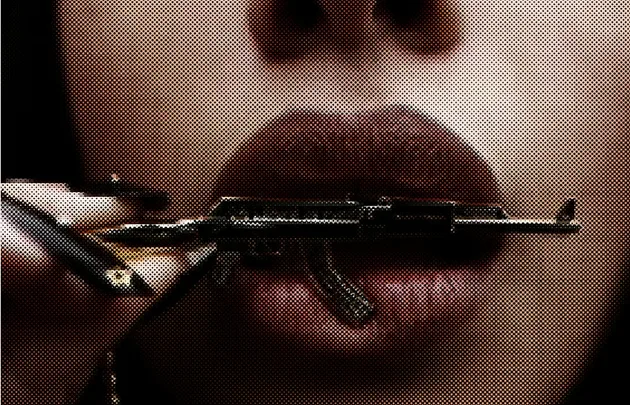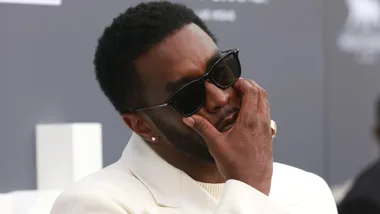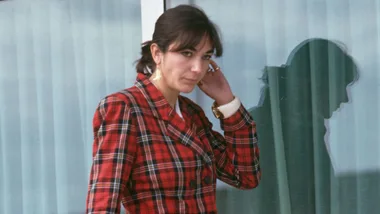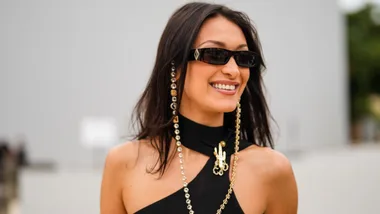Pouting into the camera, Claudia Ochoa Félix’s bright red lipstick and voluptuous figure dominate her social media feed. Raven-haired, with flawless make-up and body-con clothing, she could easily be any other Instagram star showing off her curves. But it’s not just smiles and curves. There are also shots of her posing with flashy cars and piles of cash, standing beside heavily armed guards and sporting her favourite accessory: a bright pink AK-47. Dubbed the “Kim Kardashian of crime”, Félix is the supposed head of Los Ántrax – the fearsome assassin wing of Mexico’s powerful Sinaloa drug cartel. And like her fellow drug kingpins, social media is her preferred platform for propaganda – shamelessly flaunting her wealth to the masses.

Félix is not alone in her digital devotion. Taking to Twitter and Instagram, this new generation of cartel leaders is anything but publicity shy, hashtagging their posts with #narcostyle and #narcolife to communicate with their thousands of followers. Gang members flood their feed with photos of gold-plated guns, Lamborghinis, overflowing rolls of cash and expensive seaside vacations to the Mexican resort town of Mazatlán. Today, cartels are competing not just for drug money and territory, but for social media followers. It’s all about promoting their “brand” and the narco “lifestyle”.
“Images of cartel members living a lavish lifestyle can have a strategic impact,” explains researcher Antoine Nouvet, who has reported extensively on the cartels’ social media habits. “It increases recruitment and creates an “online” fanbase among ordinary citizens.”
The most prominent exponents of #narcostyle are “narco juniors” – the heirs apparent of Mexico’s biggest cartels. According to authorities, these publicity-loving, wannabe celebrities are now key figures in the cartels their fathers created, but unlike their predecessors, crave fame and notoriety.
“The older generation did it hidden, out of fear society would stigmatise them,” reveals a long-time law enforcer in Sinaloa, who says old-school bosses didn’t even permit their photo to be taken, while allowing the occasional narcoradio (“drug ballad”) celebrating one of their feats. “But there is no longer a stigma to be being a drug trafficker. It has vanished.”
“Images of cartel bosses’ lavish lifestyle creates an online ‘fanbase’ of citizens,” says researcher Antoine Nouvet
By far the greatest online champions of this #narcolifestyle are the two sons of Joaquín Guzmán, aka El Chapo, the billionaire head of the Sinaloa cartel and Mexico’s most famous outlaw. Born into wealth and power, Iván, 32, and Alfredo Guzmán, 29, have hundreds of thousands of followers on Twitter, and treat their Facebook followers to photos of every narco-cliché imaginable: pet lions and cheetahs, Ferraris and Rolls-Royces, mansions and private planes. There are also buxom bikini babes on quad bikes, and countless stacks of $100 bills. Other prominent narco juniors include Serafín, Vicente and Ismael Zambada, whose father heads the Sinaloa cartel with El Chapo; and Vicente Carrillo Leyva, the son of Juárez cartel founder Amado Carrillo Fuentes, whose fleet of private jets gave him the nickname “Lord of the Skies”.
El Chapo’s sons have thousands of Twitter followers and treat them to photos of every narco-cliché
Regular gang members are also not immune to the narcissistic pastime. One member of the Knights Templar cartel, who calls himself “Broly Banderas”, recently made headlines after posting a series of pouty selfies on Facebook, and posing with guns, stacks of cash and even cars stuffed full of drugs. Members of Los Ántrax share photos on Instagram of gold-plated machine guns and exotic cars – all while sporting the group’s trademark skull signet ring. Before he was arrested in 2014, a hit-squad cartel boss known as “El Chino Ántrax” regularly posted shots of his Christian Louboutin shoes, Lamborghini and Bentley cars, and even an Instagram photo of him posing with Paris Hilton.
“Many narcos of the new generation grew up in mansions, accustomed to power and wealth,” comments Dr Tomás Guevara, of the Autonomous University of Sinaloa and the author of two books about violence in the state. He argues the previous generation of cartel leaders was raised on the land in poverty – as a child, El Chapo sold oranges to make ends meet, before moving on to more lucrative produce. But the ostentation of narco juniors on social media is the product of a new generation, born into the spoils of a booming drug business.

It’s hard to overstate the pervasiveness of drug cartels in Mexico today. From the 1980s until the early 2000s, the Mexican government took a relatively passive approach to cartel violence. But that changed in late 2006, with the election of President Felipe Calderón, who enlisted the Mexican Army and Navy in an aggressive campaign against the cartels – generally viewed as the starting point of the Mexican Drug War.
Figures released by the Mexican government last year showed that more than 164,000 people were murdered from 2007 to 2014, with 27,000 people killed in 2011 alone. That’s about 60,000 more than the number of civilians killed in the Afghanistan and Iraq conflicts combined. Meanwhile, fighting the drug war costs the Mexican government an estimated $240 billion a year, or roughly 10 per cent of the country’s GDP.
Yet the cartels have only grown in strength. Official figures estimate the cartels pull in $85 billion a year, with Forbes featuring El Chapo in past billionaire and “Most Powerful” lists. The New Yorker claims he may be responsible for as much as half of all US drug imports.
Social media isn’t the only technology cartels are utilising. The US Drug Enforcement Administration (DEA) reports the Mexican operations are using drones to fly drugs over the border, and have enlisted specialists to build sophisticated communications networks. But this tech has come at a high price. “They may be engaging young computer scientists in Mexico and giving them a good salary, but if they still require a skill, they just kidnap someone who has it,” Nouvet, who works with technology think-tank The SecDev Foundation, told Vice magazine. “As of 2012, we had at least 36 cases of engineers who were snatched by the cartels, including an IBM employee, never to be seen again.”
The cartels’ social media accounts are not all tiger cubs and golden guns, either. Like a large corporation, social media offers the cartels a powerful public relations tool. In 2013, the Gulf Cartel posted a YouTube video of them distributing aid after a hurricane hit Mexico. A speech by the leader of the Knights Templar currently has 2.4 million views on the video-sharing site. According to some reports, the Knights Templar at one point ran a Facebook page as a “small business” that garnered more than 10,000 likes before it was shut down.
Images of guns and bling can also be a strong recruitment tool, particularly for the 46 per cent of Mexicans who live in poverty. A well-known proverb among Mexico’s drug world is: “Better to be a prince for a year than a donkey for life.”
“Cyberspace is the main media form where the drug war finds its voice,” adds Nouvet. “Content like these Twitter accounts resonates with the hundreds of thousands of online narcocultura fans. It can provide an image of social mobility, hope and opportunity to the young poor [who] otherwise [have] few prospects.”
Dr Guevara explains that this glamorous image can also attract women, like Félix. “It’s not new for mothers or spouses to take over the business after a man’s downfall,” he says. “As in all sectors of society, women are forced into new roles to provide for their families. But the immense majority of women involved [in cartels] do it to have access to luxury that would be unavailable to them otherwise.”
With 98 per cent of homicides in Mexico going unsolved, prospective cartel members also have little worry they will be caught. Instead, the real danger comes from within. A DEA report in 2012 revealed that cartels were using social media not only to recruit new members, but to spy on existing ones – obtaining personal information and details of relatives, to be used against them if members attempt to flee.
The narco juniors have also embraced social media for distinctly chilling purposes. Shocking photos and footage – of decapitations, mutilations, torture and killings – are becoming common, invariably posted with warnings for others. In 2013, Facebook caused uproar when it refused to remove a video of a woman being beheaded by the Zeta cartel; the previous year, Gulf Cartel members beheaded five Zetas on camera. Serafín Zambada has regularly posted evidence of murders committed by men linked to his father’s cartel. Vice reported one photo from Zambada’s Facebook page showed a man whose mid-section is sliced open – just punishment for being a “rat”, he wrote.
While the cartels might be seemingly happy to use social media for their own purposes, they have reacted violently when opponents have used these channels to criticise them. In 2011, police in Nuevo Laredo found a woman’s decapitated corpse with a sign saying she had been murdered as a reprisal for posting on a social media site, reported The Guardian. The note was signed with the Zeta cartel’s “Z” trademark.
Police found a woman’s decapitated corpse, a reprisal for social media posts. A note was signed with the Zeta cartel’s “Z”
Citizen reporter Dr Maria del Rosario Fuentes used an anonymous Twitter account to post information about cartel action in her hometown near the Rio Grande. On October 15, 2014, the 36-year-old was kidnapped by armed men and tweeted a warning to her followers: “Close your account. Don’t risk your families as I have. I ask for forgiveness.” It was followed by two images: in the first she gazes into the camera. In the second she is on the ground, with a bullet in her head.
“Cyberspace and social media offers [cartels] a free ‘soapbox’ that can’t be controlled in the same way as traditional media like print and TV,” says Nouvet. “When increasing connectivity in places like Mexico is paired with high rates of violence and crime, cartel presence online is no surprise. What’s more, lack of effective law and order can lead cartel members to feel invincible online.”
Independent journalists are not the only ones to attract the cartels’ ire. After El Chapo was recaptured in January, current Mexican President Enrique Peña Nieto was quick to claim the victory, taking to Twitter to announce it was “mission accomplished”. El Chapo’s son Iván replied directly with a series of clear warnings: “You don’t know what you’ve done or the mess you’ve gotten yourself into,” said one; “Just as we put you in the presidency, we can just as easily take you out,” read another. Younger son Alfredo tweeted the government, warning they would “know of the Guzmáns very soon”.
The Mexican Drug War shows little sign of waning. Yet as authorities struggle to contain the violence that continues to ravage their country, the cartels’ newfound online savvy means authorities are faced with fighting their battles on a new online front. And as the flaunts and threats of the Guzmán brothers or the glamorous Ms Félix seem to suggest, it is a conflict cartel leaders appear to be winning – one selfie at a time.










